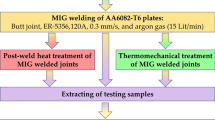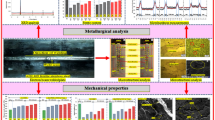Abstract
The effect of post-weld heat treatment (PWHT) time and multiple PWHT on mechanical properties of modified 9Cr-1Mo steel weld joints has been studied using multi-pass tungsten inert gas (TIG) weld joints fabricated from 12.5-mm-thick plates using matching composition ER90S-B9 filler wire. Radiographically qualified weld joints were subjected to single PWHT at 760 °C for different hold times, viz. 1, 3, 4, 8 and 12 h, as also to multiple PWHT cycles of (1 h + 3 h) and (4 h + 4 h) for comparing with single PWHT of 4 h and 8 h, respectively. Transverse-weld tensile strength of the weld joints (as also the base material) decreases marginally with increasing heat treatment duration. In all heat-treated conditions, the Charpy V-notch impact toughness of more than 200 J is obtained for the weld and base materials. Multiple PWHT is found to have no adverse effect on the tensile properties and impact toughness of the weld joint, which has been corroborated by microstructural examination and hardness measurements.









Similar content being viewed by others
References
Mitra TK, Pai A, Kumar P (2011) Challenges in manufacture of PFBR steam generators. Energy Procedia 7:317–322
Chandravathi KS, Laha K, Bhanu Sankar Rao K, Mannan SL (2001) Microstructure and tensile properties of modified 9Cr-1Mo steel (grade 91). Mater Sci Technol 17:559–565
ASME SA-387/SA-387M (2010) Specification for pressure vessel plates, alloy steel, chromium-molybdenum. American Society of Mechanical Engineers (ASME), Section II, Part A pp. 695–702
Francis JA, Mazur W, Bhadeshia HKDH (2006) Type IV cracking in ferritic power plant steels. Mater Sci Technol 22(12):1387–1395
Arivazhagan B, Sundaresan S, Kamaraj M (2009) A study on influence of shielding gas composition on toughness of flux-cored arc weld of modified 9Cr-1Mo (P91) steel. J Mater Process Technol 209:5245–5253
Maduraimuthu V, Vasudevan M, Muthupandi V, Bhaduri AK, Jayakumar T (2012) Effect of activated flux on the microstructure, mechanical properties, and residual stresses of modified 9Cr-1Mo steel weld joints. Metall Mater Trans B 43:123–132
Arivazhagan B, Vasudevan M (December 2013) A study of microstructure and mechanical properties of Grade 91 steel A-TIG weld joint. J Mater Eng Perform 22(12):3708–3716
Moitra A, Parmeswaran P, Sreenivasan PR, Mannan SL (2002) A toughness study of the weld heat-affected zone of a 9Cr-1Mo steel. Mater Charact 48:55–61
Lee WH, Shui RK, Chen C (2003) Mechanical properties of modified 9Cr-1Mo steel welds with notches. Mater Sci Eng A356:153–161
Oñoro J (2006) Martensite microstructure of 9–12 % Cr steels weld metals. J Mater Process Technol 180:137–142
Lippold JC (1981) Transformation and tempering behaviour of 12Cr-1Mo-0.3V martensitic stainless steel weldments. J Nucl Mater 103 & 104:1127–1132
Mayr P, Palmer TA, Elmer JW, Specht ED (2008) Direct observation of phase transformation in the simulated heat-affected zone of a 9Cr martensitic steel. Int J Mat Res 99(4):1–6
Mannan SL, Chetal SC, Baldev Raj, Bhoje SB. Selection of materials for prototype fast breeder reactor. www.igcar.gov.in/igc2004/PFBR.pdf
Baldev R, Mannan SL, Vasudeva Rao PR, Mathew MD (2002) Development of fuels and structural materials for fast breeder reactors. Sadhana 27(5):527–558
QW-462.1(d) (2010) Tension-reduced section-turned specimen, American Society of Mechanical Engineer (ASME) Boiler and Pressure Vessel Code – Section IX
Wang H, Zhang H, Li J (2009) Microstructure evolution of 9Cr-1Mo deposited metal subjected to weld heating. J Mater Process Technol 209:2803–2811
Author information
Authors and Affiliations
Corresponding author
Additional information
Doc. IIW-2439, recommended for publication by Commission IX "Behaviour of Metals Subjected to Welding"
Rights and permissions
About this article
Cite this article
Dey, H.C., Albert, S.K., Bhaduri, A.K. et al. Effect of post-weld heat treatment (PWHT) time and multiple PWHT on mechanical properties of multi-pass TIG weld joints of modified 9Cr-1Mo steel. Weld World 58, 389–395 (2014). https://doi.org/10.1007/s40194-014-0124-0
Received:
Accepted:
Published:
Issue Date:
DOI: https://doi.org/10.1007/s40194-014-0124-0




